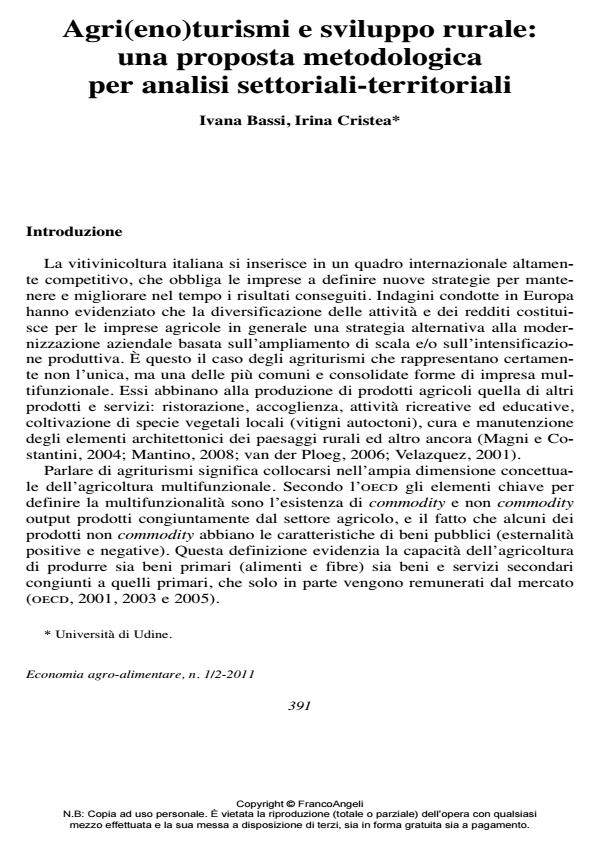Agri(eno)tourism enterprises and rural development: a methodological proposal for sector and territorial analysis
Journal title ECONOMIA AGRO-ALIMENTARE
Author/s Ivana Bassi, Irina Cristea
Publishing Year 2011 Issue 2011/1-2
Language Italian Pages 16 P. File size 209 KB
DOI 10.3280/ECAG2011-001017
DOI is like a bar code for intellectual property: to have more infomation
click here
Below, you can see the article first page
If you want to buy this article in PDF format, you can do it, following the instructions to buy download credits

FrancoAngeli is member of Publishers International Linking Association, Inc (PILA), a not-for-profit association which run the CrossRef service enabling links to and from online scholarly content.
The Italian wine sector is part of a highly competitive international framework. It requires companies to define strategies to maintain and improve their results over time. Surveys conducted in Europe on farms strategies showed that diversification of assets and income is an alternative strategy to business modernization based on enlargement of scale and/or intensification of production. This is the case of agritourism enterprises that combine the production of agricultural goods with some services like catering, hospitality, recreation, education, etc. These enterprises are the most widespread form of multifunctional agriculture. Agenda 2000 has recognized the existence of a European model of agriculture based on multifunctionality and the central role of rural areas in the diversification of farmers’ economic activities. Agritourism enterprises are part of rural tourism, which is an answer to the demand of enogastronomic, cultural, environmental, social goods which are specific components of local areas. The attractiveness of these areas depends on the possibility to strengthen and enhance existing relationships between the different actors of those systems (non only farms), also through public investment. The definition of rural development policies and instruments needs to measure the dimensions of multifunctionality (economic, social and environmental functions) and to decline it within specific local contexts. This study would represent a methodological contribution to analysis that combine sector and spatial elements, aimed to provide useful information to the regionalization of public expenditures. The process here implemented - choice of information sources and functional indicators, construction of datasets, use of clustering algorithm, with particular reference to the fuzzy one - provided a description of agri(eno)touristic characterization of the region Friuli Venezia Giulia (study area). The municipalities (statistical units) were grouped into five different clusters in function of the number of wine companies, the number of agritourism enterprises and the services offered to their customers. Moreover, fuzzy clustering allowed to identify those municipalities that have the properties of different clusters. They were regarded as "in transition", meaning that they can be moved the desired group through specific projects. From an operational point of view this information is important because enables to elaborate development programs taking into account both differences between clusters and some peculiar characteristic inside each group. Not least, the results can be a support for identifying other variables able to better describe multifunctionality, hopefully with the participation of institutions actively engaged in the development of rural areas
Keywords: Agri(eno)turistic characterization, rural development, fuzzy clustering
Jel codes: O18, Q18
Ivana Bassi, Irina Cristea, Agri(eno)turismi e sviluppo rurale: una proposta metodologica per analisi settoriali-territoriali in "ECONOMIA AGRO-ALIMENTARE" 1-2/2011, pp , DOI: 10.3280/ECAG2011-001017